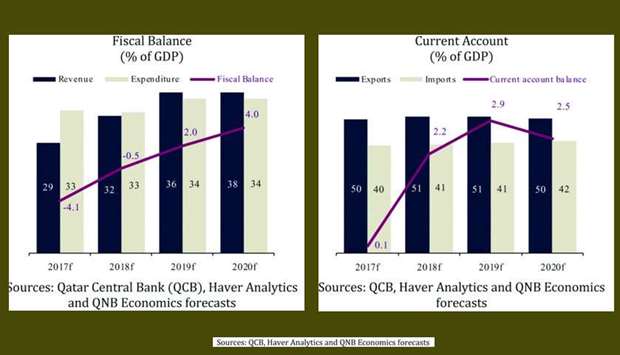Qatar’s growth is set to rise on higher oil prices, eased fiscal constraints and investments in LNG production, QNB has said in its latest ‘Qatar Economic Insight’.
The country’s real GDP is expected to rise to 2.5% this year and 3.4% in 2019 before slowing slightly to 3.3% in 2020 as higher oil prices lead to relaxed fiscal constraints and as investment in the long-term expansion of LNG production lifts growth.
In the hydrocarbon sector, the extension of the Opec output cuts agreement in 2018 will keep oil production flat, but Qatar’s hydrocarbon production should pick up thereafter as the Opec curbs are lifted and as new gas production from the Barzan project comes on line in 2020.
The country’s non-hydrocarbon sector will be supported by relaxed fiscal constraints and by investment in a raft of new projects related to the planned 30% increase in LNG production due in five-seven years’ time, which will lend support to jobs growth and domestic demand from 2019 onwards, QNB said.
The oil market is expected to balance over the near-term with prices averaging $58 for barrel in 2018 and $60 in the 2018-20 period, QNB noted.

Qatar’s inflation is expected to spike in 2018 to 2.4% with higher oil prices and the introduction of value added tax (VAT) in the second half (H2) before easing, as oil prices level off and the impact of VAT fades, to 2.1% in 2019 and 1.6% in 2020, QNB said.
The government’s budget deficit is expected to narrow to -0.5% in 2018 before switching to a surplus of 2% and 4% in 2019-20 on a recovery in hydrocarbon revenue from higher oil prices and the introduction of VAT.
Capital spending should continue in 2018 from the implementation of World Cup related projects, QNB said in its outlook for the Qatari economy.
In addition, from 2019, the country’s LNG-related projects should push capital spending up further in the country. Fiscal constraints on current spending are expected to persist in 2018 before easing in 2019-20.
Qatar’s current account surplus is expected to rise to 2.2% in 2018 and 2.9% in 2019 on higher oil prices and the eventual removal of Opec production caps, before moderating to 2.5% in 2020 as oil prices flatten, the report said.
The country’s international reserves are expected to be maintained at their current level of around six months of prospective import cover, QNB said in its ‘Qatar Economic Insight.’



